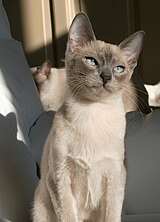Tonkinese cat
The best known variety is the short-haired Tonkinese, but there is a semi-longhaired (sometimes called Tibetan) which tends to be more popular in Europe, mainly in the Netherlands, Germany, Belgium, Luxembourg, and France.
[1] Many of the cats used to found the Siamese and Burmese in the West are believed to be Tonkinese, including Wong Mau.
[3] In the West, Tonkinese cats under the age of sixth months have historically been referred to as "small-cats" rather than "kittens" to reflect a more direct translation from Burmese, although this term has become almost obsolete since the mid-20th century.
Today the breed is recognised in most of Europe, Australia, New Zealand, Hong Kong, Japan, and South Africa.
[2] The American style is a rounder but sculpted head with a shorter body and sturdier appearance to reflect the old-fashioned Siamese and rounded Burmese from which it was originally bred in the United States.
The GCCF accepts brown, blue, chocolate, lilac, cinnamon, and fawn, red, cream, plus caramel and apricot.
[6] Like both parent breeds, Tonkinese are active, vocal and generally people-oriented cats, playful and interested in everything going on around them; however, this also means they are easily susceptible to becoming lonesome or bored.
Like Burmese, Tonkinese are reputed to sometimes engage in such dog-like behaviors as fetching, and to enjoy jumping to great heights.
[8] Tonkin is a crossbreed type, with coat color and pattern wholly dependent on whether individuals carry the Siamese or Burmese gene.

